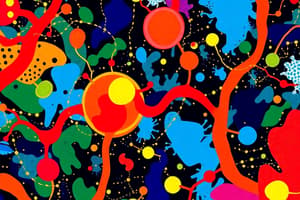Podcast
Questions and Answers
What distinguishes gated ion channels from leaky ion channels?
What distinguishes gated ion channels from leaky ion channels?
- Leaky channels are selectively permeable to specific ions.
- Gated channels are always open.
- Leaky channels require energy to open.
- Gated channels only open in response to specific triggers. (correct)
What role do ion transporters serve in cells?
What role do ion transporters serve in cells?
- They allow ions to flow freely across membranes.
- They directly generate electrical signals.
- They solely function in chemical signaling.
- They help maintain the uneven distribution of ions. (correct)
Which type of ion channel is primarily involved in intercellular signaling at chemical synapses?
Which type of ion channel is primarily involved in intercellular signaling at chemical synapses?
- Store-operated calcium channels.
- Connexin channels.
- Ligand gated channels. (correct)
- Voltage gated ion channels.
What initiates the rapid release of neurotransmitters in excitable cells?
What initiates the rapid release of neurotransmitters in excitable cells?
How do store operated calcium channels (SOCCs) contribute to cellular functions?
How do store operated calcium channels (SOCCs) contribute to cellular functions?
What is the importance of the EF-hand domain in calcium binding proteins?
What is the importance of the EF-hand domain in calcium binding proteins?
In which type of cells do both rapid and slow responses to calcium influx occur?
In which type of cells do both rapid and slow responses to calcium influx occur?
What characteristic of electrical synapses allows for the passive flow of ions?
What characteristic of electrical synapses allows for the passive flow of ions?
What role does calmodulin play in the activation of calcineurin?
What role does calmodulin play in the activation of calcineurin?
Which mechanism is NOT involved in regulating calcium levels in the cytosol?
Which mechanism is NOT involved in regulating calcium levels in the cytosol?
What triggers calcium efflux from the endoplasmic reticulum (ER)?
What triggers calcium efflux from the endoplasmic reticulum (ER)?
How does calmodulin contribute to the function of PMCA?
How does calmodulin contribute to the function of PMCA?
Which channel does NOT facilitate calcium influx into the mitochondria?
Which channel does NOT facilitate calcium influx into the mitochondria?
Why is cytosolic calcium concentration significantly lower than extracellular calcium concentration?
Why is cytosolic calcium concentration significantly lower than extracellular calcium concentration?
What is the role of STIM1 in relation to TRPC1 and TRPC3 channels?
What is the role of STIM1 in relation to TRPC1 and TRPC3 channels?
Which statement best describes the relationship between SERCA and ATP?
Which statement best describes the relationship between SERCA and ATP?
How does STIM1 interact with TRPC3 channels?
How does STIM1 interact with TRPC3 channels?
How does the concentration gradient affect calcium movement within cells?
How does the concentration gradient affect calcium movement within cells?
What activates SOCCs effectively?
What activates SOCCs effectively?
What is the role of antigen-presenting cells (APCs)?
What is the role of antigen-presenting cells (APCs)?
What structure is formed between an APC and a T cell during antigen presentation?
What structure is formed between an APC and a T cell during antigen presentation?
Which of the following statements about MHC2 is correct?
Which of the following statements about MHC2 is correct?
What is one consequence of the binding of antigen to the TCR in T cells?
What is one consequence of the binding of antigen to the TCR in T cells?
Which compound is known to transiently activate ORAI mediated Ca2+ entry before blocking it?
Which compound is known to transiently activate ORAI mediated Ca2+ entry before blocking it?
What is the role of HLA-DM in the antigen presentation process?
What is the role of HLA-DM in the antigen presentation process?
Which event immediately follows the binding of chemokines to their GPCRs on T cells?
Which event immediately follows the binding of chemokines to their GPCRs on T cells?
What initiates the hyperpolarization of T cells during the signaling process?
What initiates the hyperpolarization of T cells during the signaling process?
Which molecule is crucial for the dephosphorylation of NFAT, allowing its translocation to the nucleus?
Which molecule is crucial for the dephosphorylation of NFAT, allowing its translocation to the nucleus?
What consequence arises from the hydrolysis of PIP2 by PLC?
What consequence arises from the hydrolysis of PIP2 by PLC?
What role does NFAT play in T cell development?
What role does NFAT play in T cell development?
Which factor is crucial for the development of distinct T helper subsets?
Which factor is crucial for the development of distinct T helper subsets?
What is Severe Combined Immunodeficiency (SCID) primarily characterized by?
What is Severe Combined Immunodeficiency (SCID) primarily characterized by?
How does SOCE (store-operated calcium entry) function in neurons?
How does SOCE (store-operated calcium entry) function in neurons?
What is a major role of the cerebellum in relation to motor learning?
What is a major role of the cerebellum in relation to motor learning?
What happens at the PF-PN synapse in terms of calcium signaling?
What happens at the PF-PN synapse in terms of calcium signaling?
What condition is caused by a mutation in the TRPC3 gene?
What condition is caused by a mutation in the TRPC3 gene?
What is one potential consequence of impaired SOCE in aging-related neurodegenerative diseases?
What is one potential consequence of impaired SOCE in aging-related neurodegenerative diseases?
How do cytokines influence T cell differentiation?
How do cytokines influence T cell differentiation?
What is a result of SOC entry dysfunction in SCID patients?
What is a result of SOC entry dysfunction in SCID patients?
Flashcards are hidden until you start studying
Study Notes
Ion Channels: Introduction
- Ion channels are protein complexes forming pores allowing ion passage.
- Channels can be "leaky" (always open) or "gated" (ligand-gated or voltage-gated).
- Ion transporters maintain uneven ion distribution across cellular compartments.
- Channels reside in plasma membranes or intracellular organelle membranes.
- Ion flow is driven by concentration and electrical gradients; the cell's negative interior attracts positive ions.
- Chemical synapses use ligand-gated ion channels (LGCs) for intercellular signaling; LGC activation often triggers voltage-gated channels.
- Electrical synapses employ connexin channels for passive ion flow.
- Organelle membrane channels mediate intracellular signaling.
Store-Operated Calcium Channels (SOCCs)
- Cytosolic calcium changes are crucial signals, triggering rapid and slow cellular responses.
- Rapid responses (e.g., neurotransmitter release, muscle contraction) involve voltage-gated calcium channels in excitable cells.
- Slow responses, due to sustained calcium influx via SOCCs, occur in excitable and non-excitable cells; affecting gene transcription, cell differentiation, and migration.
- Response speed depends on channel location and calcium-binding protein distribution.
- Many calcium channels/proteins have EF-hand domains for calcium binding.
Calmodulin (CaM)
- Binds four calcium ions, undergoing a conformational change upon activation.
- Activated CaM regulates: calcineurin (involved in gene transcription via NFAT), CaM-dependent kinases (e.g., in muscle contraction), and calcium pumps/exchangers (removing calcium from the cytosol).
- The change in membrane voltage (Vm), not cytosolic calcium concentration itself, is the primary signal.
Regulating Calcium in/out of the ER
- Ligand-gated ER calcium channels mediate calcium efflux.
- GPCR activation, through PLC and IP3, triggers calcium efflux from the ER (via IP3R).
- RyR channels (RyR-1, RyR-2) on the ER/SR also mediate calcium release; some are physically coupled to L-type calcium channels.
Mitochondria-Associated Membranes (MAMs)
- Close ER-mitochondria contacts.
- VDACs (outer mitochondrial membrane) and MCUs (inner membrane) facilitate calcium influx into mitochondria.
- Grp75 protein links ER channels (like IP3R) to VDACs/MCUs.
- LETM1 and NCLX transport calcium out of mitochondria.
Restoring Low Cytosolic Calcium
- Increased cytosolic calcium activates SERCA (using ATP) to refill ER stores (via Ca2+/CaM).
- Increased cytosolic calcium also activates PMCA (plasma membrane calcium ATPase) and NCLX to transport calcium out of the cell.
Store-Operated Calcium Entry (SOCE): L2
- ER calcium depletion activates STIM1 .
- STIM1 interacts with TRPC1/3 channels, gating them (protein-protein interaction).
- STIM1’s interaction with TRPC channels is dependent on the channel subtype and is dependent on particular charged amino acid residue interactions.
- STIM1 gating of TRPC1/3 channels is dependent on specific charged amino acid interactions between STIM1 and the TRPC1/3 channels.
- SOCC inhibitors include lanthanides (ORAI blockers), 2-APB (transient activator/high-concentration blocker), and BTP2.
- SOCC activators include Gαq-coupled GPCR agonists (increasing PLC/IP3) and compounds depleting ER calcium (ionomycin, thapsigargin).
SOCC Dysregulation and Diseases: L3
Antigen Presentation to T Cells
- APCs (dendritic cells, macrophages) present processed antigens (MHC II) to T helper cells.
- Chemokines attract T cells to APCs.
- CD4+ T cells use TCR (with CD4 assistance) to recognize MHC II/antigen complexes.
- This interaction triggers STIM/ORAI-mediated CRACs, initiating T cell activation, proliferation, and differentiation.
MHC II/Antigen Processing in APCs
- Antigen endocytosis, processing in endosomes/lysosomes, MHC II loading, and presentation on the plasma membrane.
MHC II/TCR Protein Interactions
- CD4 enhances MHC II/TCR binding specificity.
- CD28/CD80 interaction stabilizes the interaction.
- Antigen/TCR binding activates tyrosine kinases (ZAP70, LAT), leading to PLC activation (PLCy1 and PLCb).
- PLC generates IP3 (causing calcium release from ER) and DAG.
- ER calcium depletion activates STIM1/ORAI, mediating calcium influx.
- Increased cytosolic calcium activates calcineurin, which dephosphorylates NFAT, causing its nuclear translocation and gene expression changes (T cell activation).
T Cell Phenotypic Differentiation
- Activated T cells differentiate into Th1, Th2, Th17, and iTreg subsets; each with unique functions, defined by signaling pathways and cytokine environment.
Severe Combined Immunodeficiency (SCID)
- Autosomal recessive disorder caused by ORAI or STIM gene mutations.
- Impairs immune cell function, leading to recurrent infections.
- Affects muscle cells (congenital myopathy) and connective tissue (sweat gland dysfunction).
SOCE Dysregulation in Neurological Diseases: L4
SOCCs in Neurons
- SOCE supports neurogenesis, synaptic formation, plasticity (learning, memory) and underlies slow EPSPs in cerebellar Purkinje neurons (motor learning).
Cerebellum
- Crucial for motor learning.
- Mossy fiber input drives granule neuron activity, influencing Purkinje cell growth and plasticity (motor learning).
Calcium Entry during Slow EPSCs
- Purkinje fiber-Purkinje neuron synapses: NTs trigger ER calcium release and SOCE via STIM1/TRPC3 (mGluR1-dependent).
Diseases
- TRPC3 mutations cause cerebellar ataxia (affecting Purkinje neuron morphology and function as result of altered SOCE.)
- Impaired SOCE may contribute to neurodegenerative diseases (reduced STIM2, impaired SOCE, reduced mature spines in Alzheimer's models).
Studying That Suits You
Use AI to generate personalized quizzes and flashcards to suit your learning preferences.




